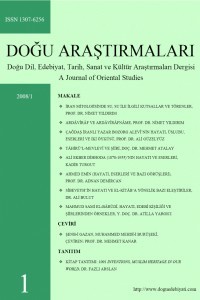CONTRASTIVE STUDY OF THE METAPHOR AND METONYMY DRIVEN SEMANTIC EXTENSIONS OF THE BODY PART WORD HAND “手” IN CHINESE AND JAPANESE LANGUAGE
CONTRASTIVE STUDY OF THE METAPHOR AND METONYMY DRIVEN SEMANTIC EXTENSIONS OF THE BODY PART WORD HAND “手” IN CHINESE AND JAPANESE LANGUAGE
___
- Kristal, Dejvid (1996) Kembrička enciklopedija jezika, Beograd: Nolit.
- Klikovac, Duška (2004) Metafore u mišljenju i jeziku, Beograd: Biblioteka XX vek, knj. 139.
- Lakoff, George. Johnson, Mark (1981) Metaphors We Live By, Chicago and London: The University of Chicago Press. (First edition 1980)
- Lakoff, George (1990) Women, Fire, and Dangerous Things – What
- Categories Reveal about the Mind, Chicago and London: The University of Chicago Press. (First edition 1987).
- Lakoff, George (1992) The Contemporary Theory of Metaphor, online source available at: http://terpconnect.umd.edu/~israel/lakoff-ConTheorMetaphor.pdf last visited on July 6th, 2012.]
- Packard, J.L. (2001) The Morphology of Chinese: A Linguistic and Cognitive
- Approach. Beijing: Foreign Language Teaching and Research Press, (originally published by Cambridge University Press, 2000).
- Chinese, which, due to the cultural specificity of Japanese language could not further develop and become more productive. Yu, Ning. (2009) The Bodily dimension of meaning in Chinese – What do we do and mean with “hands”? in Yu, Ning: From Body to Meaning in Culture: papers on cognitive semantic studies of Chinese, Amsterdam/Philadelphia
- John Benjamins Publishing Company, 2009:111-133. Jovanovic
- “人体”在概念化过程中的作用, 北京:北京师范大学 (unpublished PhD thesis) 黄伯荣, 廖序东 (2002) 现代汉语(增订三版)(上册), 北京:高等教育出版社, 163 – 裘锡圭 (1998) 文字学概要. 北京:商务印书馆.(First edition 1988.) 束定芳. (1996) 亚里斯多德与隐喻研究. 外语研究, (1):13-17. 赵倩. 北京语言大学. Dictionaries
- A New Dictionary of Kanji Usage, (1995). Gakken, Tokyo.
- Japanese – English dictionary of characters Nelson (abrev. NEL; Nelson, N. Andrew 1995: The Original Modern Reader’s Japanese-English Character
- Dictionary, Classic edition. Charles E. Tuttle Company). Rečnik Srpskohrvatskoga književnog jezika, (1990). (uređivački odbor
- Mihajlo Stevanović i dr.), Novi Sad: Matica srpska, (2. fototipsko izd.). The American Heritage Dictionary of the English Language, Fourth edition copyright 2000 by Houghton Mifflin Company, updated in 2009. Published by http://www.thefreedictionary.com/hand [last visited on 20th July, 2012.] 现代汉语词典[第5版],(2007).中国社会科学院语言研究所词典编辑室编, 商务印书馆, (First edition 2005) 汉英词典(修订版缩印本). 北京:外语教学与研究出版社, (First edition 1997) 王朝忠主编《汉字形义演释字典》 (2006). 成都: 四川出版集团: 四川辞书出版社. 『日本国語大辞典』 (編集:日本大辞典刊行会) 小学館
- 『広辞苑』第四版. (編集:新村)岩波書店 概念隐喻论与汉语人体词及其相关表达研究— (2007). 汉语人体名词词义演变规律及认知动因.博士研究生学位论文. 北京: Houghton Mifflin Company. Available at 北京: (2006). 北京外国语大学英语系词典组编, 第六巻, 第八巻, 第十四巻, 第十八巻, 第十九巻.
- ISSN: 1307-6256
- Yayın Aralığı: Yılda 2 Sayı
- Başlangıç: 2008
- Yayıncı: Ali GÜZELYÜZ
SİYASİ MEKÂN DEĞİŞİKLİĞİNİN ESER TELİFİNE YANSIMASINA BİR ÖRNEK: MUSANNİFEK
SALAR TÜRKLERİNİN MENŞEİ TARİHİ KAYNAKLARI VE GÖÇLERİ HAKKINDA KISA BİR İNCELEME
ÇİN İLE JAPONYA ARASINDAKİ KÜLTÜREL İLİŞKİLERE GENEL BİR BAKIŞ
TÂHİRÜ’L-MEVLEVÎ’NİN İLK METİN ŞERHİ DENEMESİ: “ŞEYH SA’DÎ’NİN BİR SERGÜZEŞTİ”
Jovanovıć ANA, Trıčkovıć DIVNA
TÂHİRÜ’L-MEVLEVÎ’NİN “YENİKAPI MEVLEVÎHÂNESİ POSTNİŞÎNİ ŞEYH CELÂLEDDİN EFENDİ MERHUM” ADLI ESERİ
SABZ’S POEM, JOURNEY INSIDE UNTIL RELEASE AREZOO EBRAHIMI DINAN
GELİBOLULU ÂLÎ’NİN REBÎU’L-MANZÛM ADLI ESERİ - II
